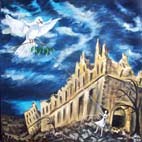

These charcoal works by Eleanor Wright are the first to arrive here for the exhibition. Eleanor is studying in Florence and was able to deliver her portrait of her grandfather and another two works in person and have a brief tour of the Liri Valley.
Eleanor writes:
My Grandfather (Poppa) was 2nd Lieutenant William Hastings Johnston of the New Zealand 18th Battalion and Armoured Regiment. He joined the Battalion in the very early days of the war in 1939 and served until leaving from Venice at the end of the war in 1945.
"Butch" as he was nicknamed served in the armoured tank division and saw active duty in North Africa and Italy. Prior to rejoining his Division in early 1944 he had spent 8 months at Sandhurst Military College at Officer Training School.
Butch rejoined his tank division and was present with the 18th at the battle for Cassino town and at the battle of Montecassino. The 18th joined with the Maori Battalion in the battle of Montecassino. My grandfather always said that the Italians and the Maori should not have been fighting against each other as they shared many of the same characteristics, a love of music and food, good humour and strong family ties. My grandfather died soon after I was born but he was always remembered as a passionate believer in the rights of every human and a larger than life personality.
I am proud to be involved in this exhibition and to present a portrait of my grandfather.
Mio nonno era 2ndo tenente William Hastings Johnston nel 18mo Battaglione e Reggimento Corazzato. Si era unito al Battaglione all'inizio della guerra nel 1939 e vi e' rimasto fino alla sua partenza da Venezia alla fine del conflitto nel 1945.
"Butch" era il suo soprannome. Ha fatto il suo servizio nella Divisione Corazzata e ha combattuto sul campo in Nord Africa e in Italia. Prima ri riunirsi alla sua divisione all'inizio del 1944 ha passato 8 mesi al Sandhurst Military College nella Scuola Ufficiali.
"Butch" si riuni' alla sua divisione corazzata e fu presente con il 18mo alla battaglia per Cassino e alla battaglia di Montecassino, a cui partecipo' anche il battaglione Maori. Mio nonno usava dire che gli Italiani e i Maori non avrebbero dovuto combattere gli uni contro gli altri perche' avevano molte caratteristiche in comune: l'amore per la musica, per il cibo, per l'umorismo e per i forti legami familiari. Mio nonno mori' poco dopo la mia nascita , e' sempre stato ricordato da chi lo circondava come un uomo appassionato per i diritti umani e con una grande personalita'.
Sono orgogliosa di partecipare a questa mostra e di esibire il ritratto di mio nonno.













































